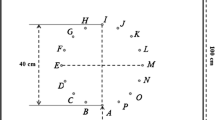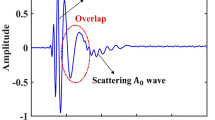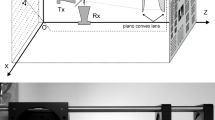Abstract
Accurate image reconstruction of damage through Lamb wave diffraction tomography (LWDT) requires substantial information of scatter field. This can be achieved using transducer network to collect the scatter field data. However, this requires a large number of transducers that creates logistical constraints for the practical applications of the technique. Various methods have been developed to improve the practicability of LWDT. One of the main approaches is to employ data at multiple frequencies within the bandwidth of the excitation signal. The objective of this study is to investigate the performance of using the data at non-central frequencies to reconstruct the damage image using LWDT. This provides an understanding on the influence of data at each individual frequency in the damage image reconstruction.In this paper, a series of numerical case studies with consideration of different damage sizes and shapes are carried out. Different non-central frequencies data is used to reconstruct the damage image. The results show that using the data at different non-central frequencies leads to different qualities of the reconstructed damage images. The quality of these reconstructed damage images are then compared to investigate the information contained of the data at each individual frequency. The study shows that the non-central frequencies data can provide additional information in the damage image reconstruction. Overall, the results of this study provide insights into the influences of the data at different frequencies, which is essential to advance the developments of the LWDT.














Similar content being viewed by others
References
Forsyth DS, Komorowski JP, Gould RW, Marincak A (1998) Automation of enhanced visual NDE techniques. In: Proceeding of the 1st Pan-American conference for NDT, Toronto. pp 107–117
Komorowski JP, Forsyth DS (2000) The role of enhanced visual inspections in the new strategy for corrosion management. Aircr Eng Aerosp Technol 71(1):5–13
Blitz J, Simpson G (1995) Ultrasonic methods of non-destructive testing. Springer, The Netherlands
Schmerr LW, Song JS (2007) Ultrasonic nondestructive evaluation systems. Springer, US
Kobayashi K, Banthia N (2011) Corrosion detection in reinforced concrete using induction healing and infrared thermography. J Civ Struct Health Monit 1:25–35
Hiasa S, Birgul R, Catbas FN (2016) Infrared thermography for civil structural assessment: demonstrations with laboratory and field studies. J Civ Struct Health Monit 6:619–636
Lepine BA, Giguere JSR, Forsyth DS, Chahbaz A, Dubois JMS (2002) Interpretation of pulsed eddy current signals for locating and quantifying metal loss in thin skin lap splices. AIP Conf Proc 615(1):415–422
Lepine BA, Holt RT (1997) An eddy current scanning method for the detection of corrosion under fasteners in thick skin aircraft structures. Can Aeronaut Sp J 43(1):28–33
Torres-Arredondo MA, Buethe I, Tibaduiza DA, Rodellar J, Fritzen CP (2013) Damage detection and classification in pipework using acousto-ultrasonics and non-linear data-driven modelling. J Civ Struct Health Monit 3(4):297–306
Gulizzi V, Rizzo P, Milazzo A, Malfa Ribolla EL (2015) An integrated structural health monitoring system based on electromechanical impedance and guided ultrasonic waves. J Civ Struct Health Monit 5(3):337–352
He S, Ng CT (2017) Modelling and analysis of nonlinear guided wave interaction at a breathing crack using time-domain spectral finite element method. Smart Mater Struct 26:085002
Yang Y, Ng CT, Kotousov A, Sohn H, Lim HJ (2018) Second harmonic generation at fatigue cracks by low-frequency Lamb waves: experimental and numerical studies. Mech Syst Signal Proc 99:760–773
Ng CT (2014) On the selection of advanced signal processing techniques for guided wave damage identification using a statistical approach. Eng Struct 67:50–60
Kurt I, Akbarov SD, Sezer S (2016) The influence of the initial stresses on Lamb wave dispersion in pre-stressed PZT/Metal/PZT sandwich plates. Struct Eng Mech 58:347–378
He S, Ng CT (2015) Analysis of mode conversion and scattering of guided waves at cracks in isotropic beams using a time-domain spectral finite element method. Electron J Struct Eng 14:20–32
Giurgiutiu V, Bao J (2004) Embedded-ultrasonics structural radar for in situ structural health monitoring of thin-wall structures. Struct Health Monit 3(2):121–140
Aryan P, Kotousov A, Ng CT, Cazzolato B (2017) A model-based method for damage detection with guided waves. Struct Control Health Monit 24(3):e1884
Quek ST, Tua PS, Wang Q (2003) Detecting anomalies in beams and plate based on the Hilbert-Huang transform of real signals. Smart Mater Struct 12(3):447–460
Flynn EB, Todd MD, Wilcox PD, Drinkwater BW, Croxford AJ (2011) Maximum-likelihood estimation of damage location in guided-wave structural health monitoring. Proc R Soc Lond A 467(2133):2575–2596
Aryan P, Kotousov A, Ng CT, Cazzolato BS (2017) A baseline-free and non-contact method for detection and imaging of structural damage using 3D laser vibrometry. Struct Control Health Monit 24(4):e1894
Tian Z, Yu L, Leckey C, Seebo J (2015) Guided wave imaging for detection and evaluation of impact-induced delamination in composites. Smart Mater Struct 24(10):105019
Zhao X, Gao H, Zhang G, Ayhan B, Yan F, Kwan C, Rose JL (2007) Active health monitoring of an aircraft wing with embedded piezoelectric sensor/actuator network: I. Defect detection, localization and growth monitoring. Smart Mater Struct 16(4):1208–1217
Purekar AS, Pines DJ, Sundararaman S, Adams DE (2004) Directional piezoelectric phased array filters for detecting damage in isotropic plates. Smart Mater Struct 13(4):838–850
He S, Ng CT (2016) A probabilistic approach for quantitative identification of multiple delaminations in laminated composite beams using guided waves. Eng Struct 127:602–614
He S, Ng CT (2017) Guided wave-based identification of multiple cracks in beams using a Bayesian approach. Mech Syst Signal Proc 84(1):324–345
Sohn H, Park HW, Law KH, Farrar CR (2007) Damage detection in composite plates by using an enhanced time reversal method. J Aerosp Eng 20(3):141–151
Malyarenko EV, Hinders MK (2001) Ultrasonic Lamb wave diffraction tomography. Ultrasonics 39(4):269–281
Wang CH, Rose LRF (2003) Plate-wave diffraction tomography for structural health monitoring. AIP Conf Proc 657(1):1615–1622
Ng CT (2015) A two-stage approach for quantitative damage imaging in metallic plates using Lamb waves. Earthq Struct 8(4):821–841
Pruell C, Kim JY, Qu J, Jacobs LJ (2009) Evaluation of fatigue damage using nonlinear guided waves. Smart Mater Struct 18(3):035003
Dutta D, Sohn H, Harries KA, Rizzo P (2009) A nonlinear acoustic technique for crack detection in metallic structures. Struct Health Monit 8(3):251–0262
Soleimanpour R, Ng CT, Wang CH (2017) Higher harmonic generation of guided waves at delaminations in laminated composite beams. Struct Health Monit 16(4):400–417
Shen Y, Cesnik CES (2017) Modeling of nonlinear interactions between guided waves and fatigue cracks using local interaction simulation approach. Ultrasonics 74:106–123
Soleimanpour R, Ng CT (2017) Locating delaminations in laminated composite beams using nonlinear guided waves. Eng Struct 131:207–219
Konstantinidis G, Drinkwater BW, Wilcox PD (2006) The temperature stability of guided wave structural health monitoring systems. Smart Mater Struct 15(4):967–976
Aryan P, Kotousov A, Ng CT, Wildy S (2016) Reconstruction of baseline time-trace under changing environmental and operational condition. Smart Mater Struct 25(3):035018
Mohabuth M, Kotousov A, Ng CT (2016) Effect of uniaxial stress on the propagation of higher-order Lamb wave modes. Int J Nonlinear Mech 86:104–111
Jansen DP, Hutchins DA (1990) Lamb wave tomography. In: IEEE 1990 ultrasonics symposium, vol 2. pp 871–874
Malyarenko EV, Hinders MK (2000) Fan beam and double crosshole Lamb wave tomography for mapping flaws in aging aircraft structures. J Acoust Soc Am 108(4):1631–1639
Leonard KR, Malyarenko EV, Hinders MK (2002) Ultrasonic Lamb wave tomography. Inverse Prob 18(6):1795–1808
Rose LRF, Wang CH (2004) Mindlin plate theory for damage detection: source solutions. J Acoust Soc Am 116(1):154–171
Belanger P, Cawley P, Simonetti F (2010) Guided wave diffraction tomography within the born approximation. IEEE Trans Ultrason Ferroelectr Freq Control 57(6):1405–1418
Rose LF, Wang CH (2010) Mindlin plate theory for damage detection: imaging of flexural inhomogeneities. J Acoust Soc Am 127(2):754–763
Huthwaite P, Simonetti F (2013) High-resolution guided wave tomography. Wave Motion 50(5):979–993
Huthwaite P (2014) Evaluation of inversion approaches for guided wave thickness mapping. Proc R Soc Lond A 470(2166):20140063
Devaney AJ, Dennison M (2003) Inverse scattering in inhomogeneous background media. Inverse Prob 19(4):855–870
Rohde AH, Rose LRF, Veidt M, Wang CH (2009) Two inversion strategies for plate wave diffraction tomography. Mater Forum 33:489–495
Ng CT (2015) On accuracy of analytical modelling of Lamb wave scattering at delaminations in multilayered isotropic plates. Int J Struct Stab Dyn 15(8):1540010
Soleimanpour R, Ng CT (2016) Scattering of the fundamental anti-symmetric Lamb wave at through-thickness notches in isotropic plate. J Civ Struct Health Monit 6:447–459
Chan E, Rose LF, Wang CH (2015) An extended diffraction tomography method for quantifying structural damage using numerical Green’s functions. Ultrasonics 59:1–13
Rajagopal P, Drozdz M, Skelton EA, Lowe MJS, Craster RV (2012) On the use of absorbing layers to simulate the propagation of elastic waves in unbounded isotropic media using commercially available finite element packages. NDT E Int 51:30–40
Ng CT (2014) Bayesian model updating approach for experimental identification of damage in beams using guided waves. Struct Health Monit 13(4):359–373
Acknowledgements
The research described in this paper was financially supported by the Australian Research Council under Grant Number DE130100261. The support is greatly appreciated.
Author information
Authors and Affiliations
Corresponding author
Rights and permissions
About this article
Cite this article
Pudipeddi, G.T., Ng, CT. & Kotousov, A. Effect of central and non-central frequency components on the quality of damage imaging. J Civil Struct Health Monit 8, 49–61 (2018). https://doi.org/10.1007/s13349-017-0258-z
Received:
Accepted:
Published:
Issue Date:
DOI: https://doi.org/10.1007/s13349-017-0258-z




